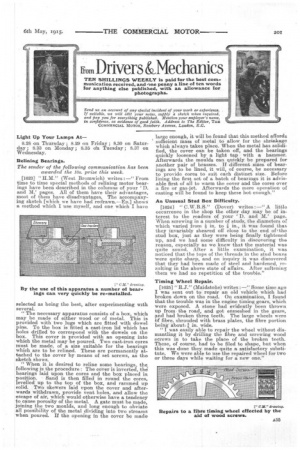TEN SHILLINGS WEEKLY is paid for the best corn,. munication
Page 21

If you've noticed an error in this article please click here to report it so we can fix it.
received, and gne penny a line of ten words for anything else published, with an allowance for photographs.
Send us an account of any special incident of your work or experience. If suitable, we will edit your notes, suPPly a sketch when required, and pay you for everything published. Mention your employer's name, in confidence, as evidence of good faith. Address to The Editor, THE COMMERCIAL MOTOR, Rosebery Avenue, London, E.C.
Light Up Your Lamps At
8.28 on Thursday ; 8.29 on Friday ; 8.30 on Saturday ; 8.33 on Monday ; 8.35 on Tuesday ; 8.37 on Wednesday.
Relining Bearings.
The sender of the following communication has been awarded the los. prize this week.
[1623] "11.M." (West Bromwich) writes :—" From time to time special methods of relining motor bearings have been described in the columns of your D. and M.' pages. All of them have their advantages, most of them have disadvantages. The accompanying sketch [which we have had redrawn.—En.] shows a method which 1 use myself, and one which I have
selected as being the best, after experimenting with several.
" The necessary apparatus consists of a box, which may be made of either wood or of metal.. This is provided with two lugs which are fitted with dowel pins. To the box is fitted a cast-iron lid which has holes drilled to correspond with the dowels on the box. This cover is provided with an opening into which the metal may be poured. Two cast-iron cores roust be made., of a size suitable for the bearings which are to be. relined. These are permanently attached to the cover by means of set screws, as the sketch shows.
" When it is desired to reline some bearings, the following is the procedure : The cover is inverted, thel bearings laid upon the cores and the box placed in position. Sand is then filled in round the cores, levelled up to the top of the box, and rammed up solid. Two skewers laid upon the cover and afterwards withdrawn, provide vent holes, and allow the escape of air, which would otherwise have a tendency to cause porosity of the metal. A gate must be made, joining the two moulds, and long enough to obviate all possibility of the metal dividing into two streams when poured. If the opening in the cover be made large enough, it will be found that this method affords sufficient mass of metal to allow for the shrinkage which always takes place. When the metal has solidified, the cover can be taken off, and the bearings quickly loosened by a light tap with a hammer. Afterwards the moulds can quickly be prepared for another pair of brasses. If different sizes of bearings are to be lined, it will, of course, be necessary to provide cores to suit each distinct size. Before lining the first set of a batch of bearings it is advisable first of all to warm the cover and the cores over a fire or gas-jet. Afterwards the mere operation of casting will be found to keep these hot enough."
An Unusual Stud Box Difficulty.
[1624] " C.W.B.S." (Dover) writes:—" A little occurrence in the shop the other day may be of interest to the readers of your 'P. and M.' page. When screwing in a number of studs, the diameters of which varied from in. to in., it was found that they invariably sheared off close to the end of the stud box, just as they were being finally tightened up, and we had some difficulty in discovering the reason, especially as we knew that the material was quite sound. After a little examination, it was noticed that the tops of the threads in the stud boxes were quite sharp, and on inquiry it was discovered that they had been made of steel and hardened, resulting in the above state of affairs. After softening them we had no repetition of the trouble."
Timing Wheel Repair.
[1625] "R.J." (Maidstone) writes :—" Some time ago I was sent out to repair an old vehicle which had broken down on the road. On examination, I found that the trouble was in the engine timing gears, which were exposed. A stone had evidently been thrown up from the road, and got enmeshed in the gears, and had broken three teeth. The large wheels were bf fibre, shrouded with brass plates, the fibre portion being about: in. wide.
" was easily able to repair the wheel without dismantling it by drilling the fibre and screwing wood screws in to take the place of the broken teeth. These, of course, had to be filed to shape, but when this was done they made quite a satisfactory substitute. We were able to use the repaired wheel for two or three days while waiting for a new one."






















